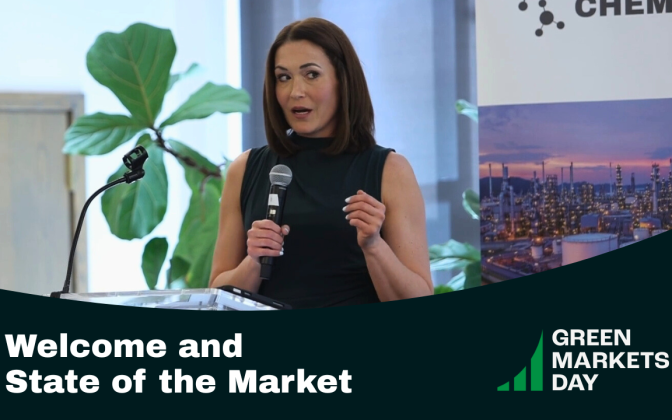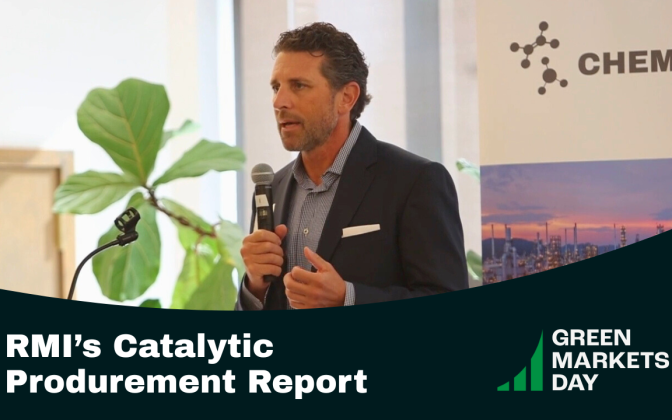10.27.25
Green Markets Day 2025 – RMI’s Catalytic Procurement Report
In this Spotlight Session during Green Markets Day 2025 at New York Climate Week, Josh Henretig, Managing Director introduces RMI’s Climate Intelligence “Catalytic Procurement” report. To learn more, visit the RMI website.
See below for a full transcript.
JOSH HENRETIG:
My name is Josh Henretig. I’m a managing director for RMI. I lead the Climate Intelligence program at RMI.
The Climate Intelligence program is really focused on how to catalyze and scale these consequential climate-differentiated markets that we’ve been talking about here. We do that by bringing product-level data together with robust carbon accounting standards, market incentives, and mechanisms like we’ve talked about here on stage. And we use those things to try and scale the markets that we can see around us now — markets like energy, like aviation, like steel.
So I’m excited to be here today to talk to you about a new report. The TLDR here is that we have a new report out that I’d encourage you all to download. There’s a link here and a QR code you can scan.
Before joining RMI, though, I spent almost 20 years at Microsoft, where I helped establish and lead the company’s climate strategy and investments. And Microsoft’s early sustainability journey borrowed a page from what was discussed earlier on stage. It was a fail-fast culture, and fail we certainly did.
I vividly remember two defining moments from the 2010 era — for those of you that can remember that far back. Around that time, we created the company’s internal carbon fee. It was groundbreaking at that time, and remarkably, it’s still around today.
But we also declared a commitment to carbon neutrality, which at the time we thought we could meet by making a set of investments in RECs — unbundled RECs, to boot. Unfortunately, those didn’t work out how we thought they did. And among the reasons that they didn’t is, of course, we know now that they don’t really bring and catalyze new energy on the grid.
That realization was pivotal. And in 2012, shortly thereafter, we made a big pivot and started an investment in many rounds of long-form PPAs — the first of which was a Kichai wind project in Texas. That really moved Microsoft then from a passive buyer to a catalytic market maker — a role it now occupies today.
And that experience really taught me that it’s not just what the company is buying — it’s really how companies are buying. And thankfully, companies don’t need to stumble in the dark like I did in 2010.
RMI’s new report, which you can download here with the QR code, is really about catalytic procurement and providing a roadmap for how corporations can participate and lead in a green commodity transition. It really focuses on how to move beyond symbolism and how to tip entire industries — like steel, aviation, shipping, and cement — forward with clean, differentiated, low-emissions products.
There are really three insights that stand out to me.
The first is that the scale of this potential is massive. For low-emission steel alone, we think that could reach 45,000,000 tons by 2030 — sufficient to justify building at least twenty first-of-a-kind plants in the sector.
Second, first movers win. In aviation, members of the Sustainable Aviation Buyers Alliance have already committed nearly $200 million toward sustainable aviation fuel certificates, which can unlock the equivalent of 50 million gallons of cleaner jet fuel. That demand signal is really bankrolling next-generation SAF projects that otherwise wouldn’t be built.
Last but not least, we need to rethink the tools. Direct physical purchase — as discussed earlier on stage — of low-emission products really should come first, and demand aggregation through buyers alliances can help pool purchasing power to make this more feasible.
But when physical delivery isn’t possible, which isn’t the case in every scenario, Environmental Attribute Certificates, or EACs-based procurement, facilitated through book-and-claim systems, may actually be essential to scaling these markets. Done right, with credible registries and standards, they allow buyers downstream in the value chain to cover the green premium and bring new supply online.
So the call to action here — the lesson we’re trying to communicate — is that whether you’re in steel, cement, fuels, or plastics, catalytic procurement isn’t about buying the label. It’s about using your demand signal. It’s about using your platform and capital to catalyze entirely new markets.
Corporates are essential drivers, but they’re not doing this alone. It’s policymakers, financiers, NGOs like us, like GMA — they must all play their part. So I’d encourage you to read more about what we found in our research. You can scan the QR code, share with your friends, and let us know what you think.
Thanks so much.










